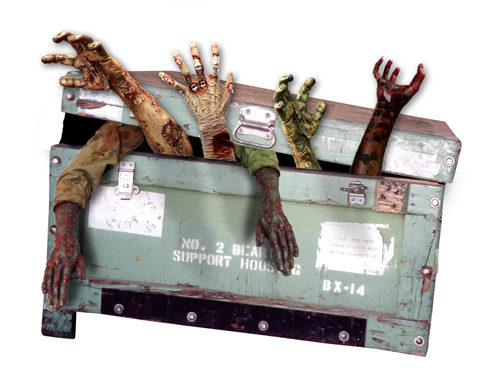
Dead and decaying boxes coming back to life sounds like something straight out of a Zombie movie. Undead wooden shipping crates may not be on the hunt for brains but they will eat away at your bottom line with the space they take up.
Save your company from the Box Apocalypse today, before it's too late!
Enough scare tactics!
 The best way to stay ahead of being overrun by dead wooden shipping crates roaming your shipping area is to assess the possibility of turning them into reusable crates.
The best way to stay ahead of being overrun by dead wooden shipping crates roaming your shipping area is to assess the possibility of turning them into reusable crates.
For manufacturing companies who operate in a closed-loop system, it pays to bring old wooden shipping crates back to life with refurbishing programs, think of it as a zombie spa day. Refurbishing helps businesses recondition out-of-service crates into reusable crates for half the cost of buying a new one.
 Fortunately, the undead wooden shipping crates at your company aren't seeking the warm flesh of the living, but keep in mind they do have some value left in their cold dead bodies.
Fortunately, the undead wooden shipping crates at your company aren't seeking the warm flesh of the living, but keep in mind they do have some value left in their cold dead bodies.
Often the hardware and much of the wood still hold value. This helps manufacturers recoup their initial investment and also save the world.
 Valley Box can combine a refurbishing program with a wood and steel recycling program to help companies save the world through environmental stewardship. When a company decides to refurbish their wooden shipping crates they end up playing a central role in helping decrease the amount of waste that ends up roaming our landfills.
Valley Box can combine a refurbishing program with a wood and steel recycling program to help companies save the world through environmental stewardship. When a company decides to refurbish their wooden shipping crates they end up playing a central role in helping decrease the amount of waste that ends up roaming our landfills.
Materials sourced to create the initial crate avoid the landfill as well as any materials that would have been required to build a new crate, which would have eventually found their way to a landfill.
After the dead crate is inspected, we begin the resurrection:
- 1. Decaying and unusable materials are removed and disposed of or recycled.
- 2. The crate has materials added to rebuild it to the specification such as new wood, hardware, paint, or foam.
- 3. Then the reusable shipping crates are reintroduced to the shipping cycle as a like-new member of society.
Opting for a refurbishing program will positively affect a manufacturer's bottom line because it will always end up costing less than it would replace. In fact, Valley Box practices The 50% Rule:
Decide to repair if the costs are less than
50% of a brand new crate.






